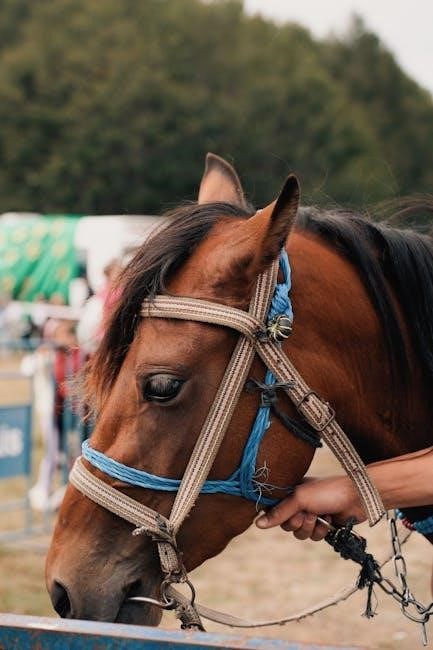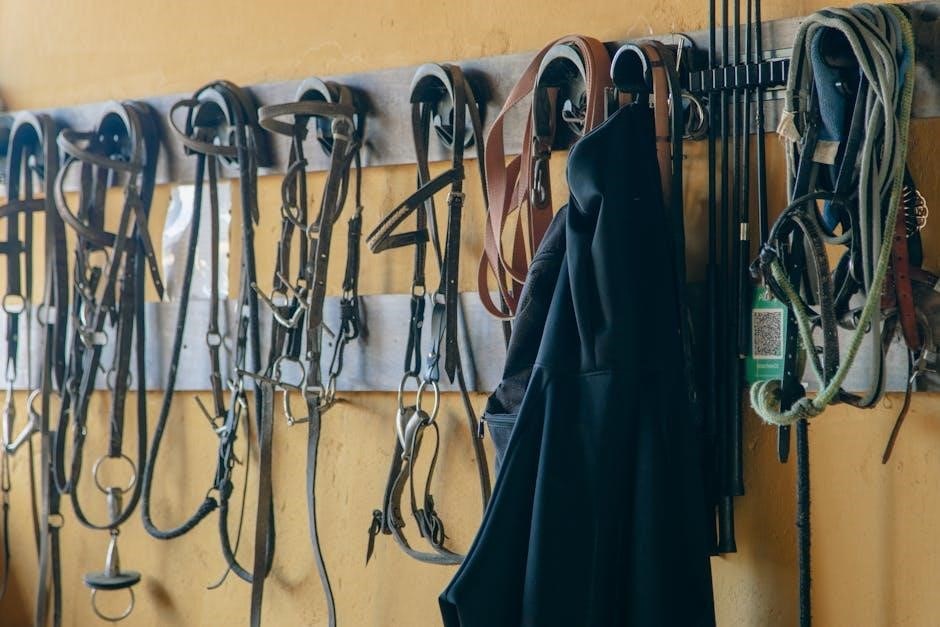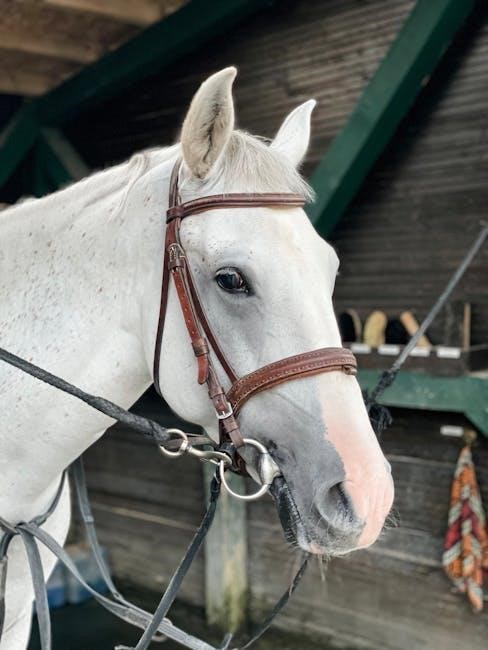
Horse bits are essential tools for clear communication between horse and rider. They come in various types and materials, each designed for specific needs and disciplines.
Understanding the Basics of Horse Bits
Horse bits are essential tools for establishing clear communication between a horse and its rider. They function by applying pressure to the horse’s mouth, cheeks, and poll, which helps guide the horse’s movements. A well-fitted bit ensures comfort and effectiveness, allowing the horse to respond to cues without discomfort. The basic components of a bit include the mouthpiece, cheek pieces, and reins, each playing a specific role in how the bit operates. Understanding how these elements work together is crucial for selecting the right bit for your horse. Proper use and maintenance are also vital to ensure the bit remains functional and comfortable for the horse. By grasping these fundamentals, riders can improve their communication and partnership with their horses.
Key Components of a Horse Bit
A horse bit consists of a mouthpiece, cheek pieces, and reins. Each component plays a specific role in how the bit functions and communicates with the horse.
Mouthpiece: Types and Functions
The mouthpiece is the part of the bit that sits inside the horse’s mouth, directly influencing comfort and communication. It comes in various types, such as jointed, mullen, and double-jointed designs. Jointed mouthpieces allow for some flexibility, applying pressure to the bars of the mouth and tongue, while mullen mouthpieces are solid and distribute pressure evenly. Double-jointed mouthpieces combine elements of both, offering mild to moderate leverage. The choice of mouthpiece depends on the horse’s sensitivity, training level, and the rider’s discipline. Proper fit and material are crucial to ensure the horse’s comfort and responsiveness to cues, making it a critical component in horse-bit selection.
Cheek Pieces: Their Role and Varieties
Cheek pieces are essential for maintaining the bit’s stability and aiding in steering. Fixed cheek designs keep the bit steady, offering mild poll pressure and clear directional cues. Loose cheek pieces, like those in snaffle bits, allow the bit to rotate, providing lateral control. Materials vary, with options like stainless steel, rubber, or synthetic, each offering different levels of durability and comfort. The shape and style of cheek pieces, whether straight, curved, or adorned, can influence both functionality and aesthetics. Properly fitted cheek pieces ensure the bit functions effectively, enhancing communication between horse and rider while minimizing discomfort. Choosing the right style depends on the horse’s needs and the rider’s discipline, ensuring optimal performance and harmony.
Reins and Their Connection to the Bit
Reins serve as the primary link between the rider’s hands and the horse bit, enabling clear communication. They transmit subtle signals from the rider to the bit, influencing the horse’s response. Proper rein handling ensures the bit functions effectively, while excessive or inconsistent pressure can lead to discomfort or confusion. The connection between reins and bit is crucial for balanced control, allowing riders to guide the horse smoothly; Different rein styles, such as direct or indirect action, can alter how the bit engages, making it essential to pair reins appropriately with the chosen bit type. This harmony ensures effective communication and a responsive, comfortable ride for the horse.

Types of Horse Bits
Horse bits come in various types, each designed for specific purposes. Snaffle, curb, Pelham, and gag bits offer unique communication styles to suit different horses and riding disciplines.
Snaffle Bits: Design and Usage
Snaffle bits are the most common type, characterized by a jointed or straight mouthpiece. They apply pressure to the horse’s bars, lips, and tongue, providing clear communication. Often used for young or inexperienced horses, they promote gentle guidance. Riders can choose between loose-ring, eggbutt, or full-cheek snaffles, each offering varying stability. The loose-ring is flexible, while eggbutt and full-cheek provide more fixed positioning, reducing the risk of the bit moving excessively. Snaffles are ideal for training, as they encourage responsiveness without causing undue pressure, making them a popular choice across multiple disciplines for horses at different stages of their education.
Curb Bits: Mechanism and Applications
Curb bits operate using leverage, applying pressure to the horse’s poll, chin groove, and bars. They feature a curb chain and a port, which can vary in size. The chain tightens when the reins are pulled, creating mild to strong pressure. This design is effective for horses that require more precise control. Curb bits are commonly used in advanced disciplines like dressage or western pleasure. They suit well-trained horses, as they offer refined communication. The bit’s mechanism encourages the horse to lower its head and respond to subtle cues, making it ideal for experienced riders seeking nuanced control and clear guidance in specific riding styles.
Pelham and Gag Bits: Specialized Uses
Pelham and gag bits are specialized tools designed for specific training or behavioral needs. The Pelham bit combines a snaffle and curb in one, offering dual action. It features a port and curb chain, allowing riders to apply both direct and leveraged pressure. Gag bits, like the elevator or waterford, work on different principles, often using a sliding ring to apply pressure to the horse’s lips and poll. These bits are typically used for young or strong horses needing additional control. They are effective in training situations where clear communication and precise guidance are essential, helping to establish proper head carriage and response to aids. However, they require skilled handling to avoid discomfort or resistance.

Choosing the Right Bit for Your Horse
Selecting the right bit involves considering factors like the horse’s age, breed, discipline, and the rider’s experience to ensure effective communication and comfort.
Factors to Consider: Horse Age, Breed, and Discipline
When choosing a bit, consider your horse’s age, breed, and discipline. Young horses may require milder bits to avoid discomfort and promote proper training. Certain breeds, like Arabians or Warmbloods, may have specific mouth conformations that affect bit fit. The discipline also plays a key role; for example, dressage often uses double bridles, while jumping might prefer a single snaffle or curb. Understanding these factors ensures the bit is tailored to the horse’s needs, enhancing communication and performance. A correctly matched bit supports the horse’s comfort and responsiveness, making it a crucial element in training and competition. Always prioritize the horse’s well-being and specific requirements. Proper fit and suitability are essential for optimal results.
Materials: Stainless Steel, Rubber, and More
Horse bits are crafted from various materials, each offering unique benefits. Stainless steel bits are durable, rust-resistant, and easy to clean, making them a popular choice. Rubber bits are softer and gentler on the horse’s mouth, ideal for sensitive or young horses. Copper and sweet iron bits encourage salivation, promoting a more comfortable mouth experience. The material choice should align with the horse’s needs, discipline, and rider preference. Selecting the right material ensures the bit is effective while maintaining the horse’s comfort and responsiveness. Proper material selection is crucial for clear communication and a positive riding experience. Always consider the horse’s specific requirements when choosing a bit material.
Bit Size and Fit: Ensuring Comfort and Effectiveness
Proper bit size and fit are crucial for a horse’s comfort and responsiveness; A bit that is too small can cause discomfort, while one that is too large may not communicate effectively. Measure the horse’s mouth to determine the correct size, ensuring the bit sits comfortably without putting pressure on the cheeks or interfering with the teeth. The bit should rest gently on the bars of the mouth, allowing for clear communication. Regular dental checks are essential to ensure proper fit, as dental issues can affect how the bit sits. A well-fitting bit promotes relaxation, trust, and effective communication between horse and rider. Always prioritize comfort to ensure the best performance and well-being of the horse.

Proper Use and Maintenance
Proper use and maintenance of horse bits involve regular cleaning, inspections for wear, and ensuring correct fit to guarantee optimal performance and horse safety.
How to Clean and Maintain Your Horse Bit
Regular cleaning and maintenance of horse bits are crucial for hygiene and functionality. Start by rinsing the bit with warm water to remove debris. Use a mild soap and a soft cloth to scrub away dirt and saliva residue, ensuring no harsh chemicals are used. Dry thoroughly to prevent rust or corrosion. Inspect for wear, cracks, or sharp edges, replacing the bit if damaged. Proper maintenance ensures the bit remains comfortable and effective, promoting clear communication between horse and rider. Regular dental checks for your horse are also essential to ensure the bit fits correctly and functions as intended.
Signs of a Well-Fitting Bit
A well-fitting horse bit ensures comfort and clear communication; Look for a quiet mouth, with no excessive chewing or head tossing. The horse should respond willingly to cues without resistance. The bit should sit evenly, avoiding pressure points, and allow for a relaxed jaw and headset. If the bit causes tension, discomfort, or evasion, it may not fit properly. A correctly fitting bit promotes focus and willingness, enabling the horse to perform at its best. Always observe your horse’s behavior and adjust as needed to ensure optimal fit and comfort.

Common Mistakes to Avoid
Using the wrong bit for your horse’s needs and improperly fitting bits are common errors. Avoid over-tightening cheek pieces, as this can cause discomfort and confusion.
Over-Tightening the Cheek Pieces
Over-tightening the cheek pieces is a common mistake that can cause significant discomfort for the horse. When the cheek pieces are too tight, they restrict the horse’s movement and can apply constant pressure on the mouth and jaw. This can lead to a range of issues, including anxiety, resistance, and even physical harm. It is crucial to ensure that the cheek pieces are adjusted properly, allowing the horse to move comfortably without feeling restricted. Proper adjustment ensures effective communication between the horse and rider while maintaining the horse’s well-being. Always check the fit and tension of the cheek pieces before riding to avoid this issue.
Using the Wrong Bit for the Horse’s Needs
Using the wrong bit for your horse’s needs can lead to discomfort, anxiety, and even resistance during training. Each horse has unique requirements based on its age, breed, and discipline, and selecting a bit that doesn’t align with these factors can hinder communication and performance. For example, a bit designed for a young horse may not suit an experienced competitor, and vice versa. It is essential to understand your horse’s specific needs and choose a bit that promotes comfort and clear communication. Consulting with an equine professional can help ensure the right bit is selected, avoiding potential behavioral or training issues.
Selecting the right horse bit is crucial for effective communication and your horse’s comfort. Consider age, discipline, and individual needs to ensure proper fit and performance.
Final Tips for Selecting and Using Horse Bits
When choosing a bit, prioritize your horse’s comfort and specific needs. Always opt for the mildest bit that ensures clear communication. Proper fitting is essential to avoid discomfort or resistance. Regularly inspect and clean the bit to maintain hygiene and functionality. Consider consulting a professional if unsure about the right type for your horse. Remember, every horse is unique, so be patient and willing to try different options until you find the perfect fit. A well-chosen bit fosters trust and enhances performance, making it a vital investment for both you and your horse.